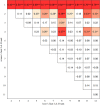Major urinary protein levels are associated with social status and context in mouse social hierarchies
- PMID: 28931741
- PMCID: PMC5627211
- DOI: 10.1098/rspb.2017.1570
Major urinary protein levels are associated with social status and context in mouse social hierarchies
Abstract
We have previously shown that male mice living in groups of 12 males establish and maintain stable linear social hierarchies with each individual having a defined social rank. However, it is not clear which social cues mice use to signal and recognize their relative social status within their hierarchy. In this study, we investigate how individual social status both in pairs and in groups affects the levels of major urinary proteins (MUPs) and specifically MUP20 in urine. We housed groups of adult outbred CD1 male mice in a complex social environment for three weeks and collected urine samples from all individuals repeatedly. We found that dominant males produce more MUPs than subordinates when housed in pairs and that the production of MUPs and MUP20 is significantly higher in alpha males compared with all other individuals in a social hierarchy. Furthermore, we found that hepatic mRNA expression of Mup3 and Mup20 is significantly higher in alpha males than in subordinate males. We also show that alpha males have lower urinary creatinine levels consistent with these males urinating more than others living in hierarchies. These differences emerged within one week of animals being housed together in social hierarchies. This study demonstrates that as males transition to become alpha males, they undergo physiological changes that contribute to communication of their social status that may have implications for the energetic demands of maintaining dominance.
Keywords: MUP20; creatinine; major urinary protein; social dominance; social hierarchy.
© 2017 The Author(s).
Conflict of interest statement
We declare no competing interests.
Figures




Similar articles
-
Social context-dependent relationships between mouse dominance rank and plasma hormone levels.Physiol Behav. 2017 Mar 15;171:110-119. doi: 10.1016/j.physbeh.2016.12.038. Epub 2017 Jan 6. Physiol Behav. 2017. PMID: 28065723
-
Distinct immune and transcriptomic profiles in dominant versus subordinate males in mouse social hierarchies.Brain Behav Immun. 2022 Jul;103:130-144. doi: 10.1016/j.bbi.2022.04.015. Epub 2022 Apr 18. Brain Behav Immun. 2022. PMID: 35447300
-
Social dominance-related major urinary proteins and the regulatory mechanism in mice.Integr Zool. 2015 Nov;10(6):543-54. doi: 10.1111/1749-4877.12165. Integr Zool. 2015. PMID: 26331981
-
The establishment and maintenance of dominance hierarchies.Philos Trans R Soc Lond B Biol Sci. 2022 Feb 28;377(1845):20200450. doi: 10.1098/rstb.2020.0450. Epub 2022 Jan 10. Philos Trans R Soc Lond B Biol Sci. 2022. PMID: 35000449 Free PMC article. Review.
-
Neural systems that facilitate the representation of social rank.Philos Trans R Soc Lond B Biol Sci. 2022 Feb 28;377(1845):20200444. doi: 10.1098/rstb.2020.0444. Epub 2022 Jan 10. Philos Trans R Soc Lond B Biol Sci. 2022. PMID: 35000438 Free PMC article. Review.
Cited by
-
Inheritance of social dominance is associated with global sperm DNA methylation in inbred male mice.Curr Zool. 2022 Apr 22;69(2):143-155. doi: 10.1093/cz/zoac030. eCollection 2023 Apr. Curr Zool. 2022. PMID: 37092005 Free PMC article.
-
Behavioral tests for the assessment of social hierarchy in mice.Front Behav Neurosci. 2025 Mar 5;19:1549666. doi: 10.3389/fnbeh.2025.1549666. eCollection 2025. Front Behav Neurosci. 2025. PMID: 40110389 Free PMC article. Review.
-
Social hierarchy position in female mice is associated with plasma corticosterone levels and hypothalamic gene expression.Sci Rep. 2019 May 13;9(1):7324. doi: 10.1038/s41598-019-43747-w. Sci Rep. 2019. PMID: 31086272 Free PMC article.
-
Foraging dynamics are associated with social status and context in mouse social hierarchies.PeerJ. 2018 Sep 19;6:e5617. doi: 10.7717/peerj.5617. eCollection 2018. PeerJ. 2018. PMID: 30258716 Free PMC article.
-
Aggression in Group-Housed Male Mice: A Systematic Review.Animals (Basel). 2022 Dec 30;13(1):143. doi: 10.3390/ani13010143. Animals (Basel). 2022. PMID: 36611751 Free PMC article. Review.
References
-
- Berry R. 1970. The natural history of the house mouse. Field Stud. 3, 219–262.
-
- Crowcroft P. 1973. Mice all over. Chicago, IL: Chicago Zoological Society.
-
- Hurst JL. 1990. Urine marking in populations of wild house mice Mus domesticus rutty. I. Communication between males. Anim. Behav. 40, 209–222. (10.1016/S0003-3472(05)80916-9) - DOI
MeSH terms
Substances
LinkOut - more resources
Full Text Sources
Other Literature Sources
Miscellaneous

